How Much Are Pink Pearls Worth? Find Out Here!
Published: 3 Mar 2025
Thinking about buying pink pearls? You’re not alone! These soft, romantic gems have become a favorite in jewelry collections, thanks to their beautiful blush and rose tones. Whether you’re into timeless necklaces or dainty earrings, pink pearls add that perfect touch of elegance. But before you spend your money, it’s important to understand the value of pink pearls and what actually makes one more expensive than another.
In this guide, I’ll walk you through how much pink pearls are worth, what affects their price, and what to look for when shopping. We’ll cover everything from pearl size, shape, surface quality, nacre, color intensity, and even things like brand and origin. That way, you’ll know exactly what you’re paying for and get the most beauty and value from your pink pearl purchase!
If you haven’t yet explored our previous blog on pearl varieties. I highly recommend reading it first for a complete understanding of pearl types and quality.
What Affects the Value of Pink Pearls?
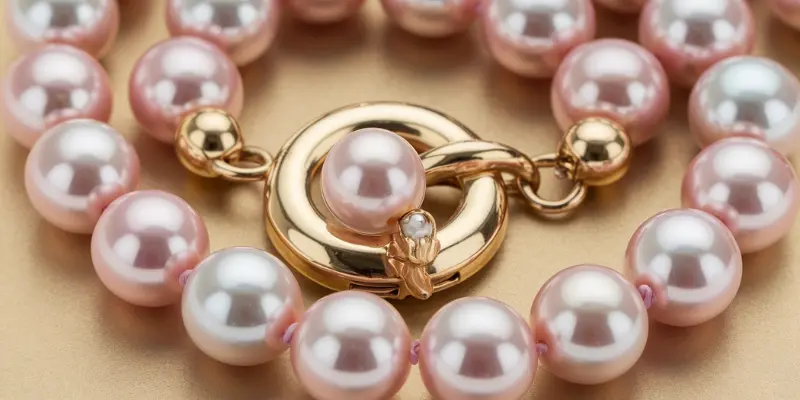
When determining the value of pink pearls, several important factors come into play. These include the shape, size, surface quality, nacre thickness, color, and how well the pearls match with each other. Let’s break these down.
Pearl Shape
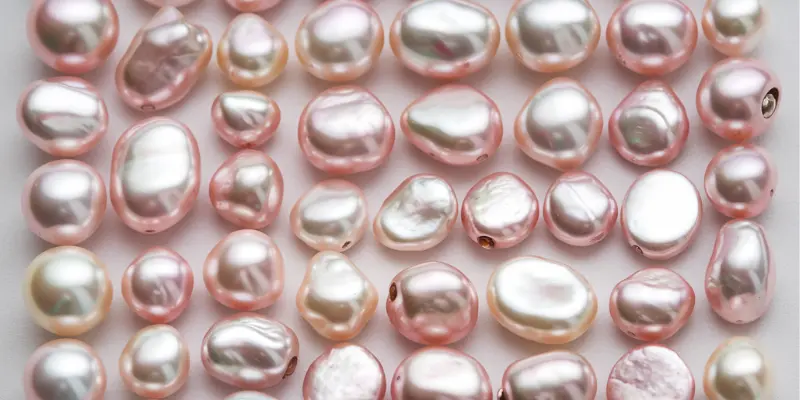
The shape of a pearl affects its price significantly. Round pearls are the most valuable because they are rare and perfectly symmetrical. In contrast, baroque pearls (irregular shapes) are less expensive but still valued for their unique look. Round pearls are prized for their uniformity, which is why they are used in high-end jewelry.
Pearl Size
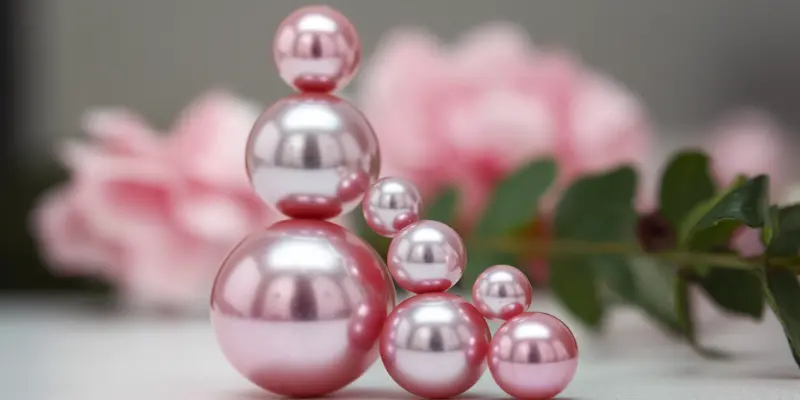
Size plays a key role in the value of a pearl. Larger pearls are more valuable due to their rarity. For example, pearls over 9mm in diameter are considered large, while those under 6mm are considered small. Larger pearls, like South Sea or Tahitian varieties, also require more time to form, adding to their value.
Surface Quality

A pearl’s surface quality is evaluated based on its smoothness and the number of blemishes. The fewer imperfections (like cracks or spots), the higher the value. Pearls are graded from “A” (almost perfect) to “C” (heavily blemished). Pearls with few or no visible flaws reflect more light and have better luster, contributing to their overall value.
Nacre Quality

Nacre is the substance that forms the pearl. Thicker nacre increases both the durability and luster of the pearl. Pearls with thin nacre are more susceptible to damage and lack the deep shine of thicker nacre pearls. High-quality nacre contributes to a pearl’s overall appearance and value, with the best pearls often having nacre 0.8mm or more thick.
Color Intensity
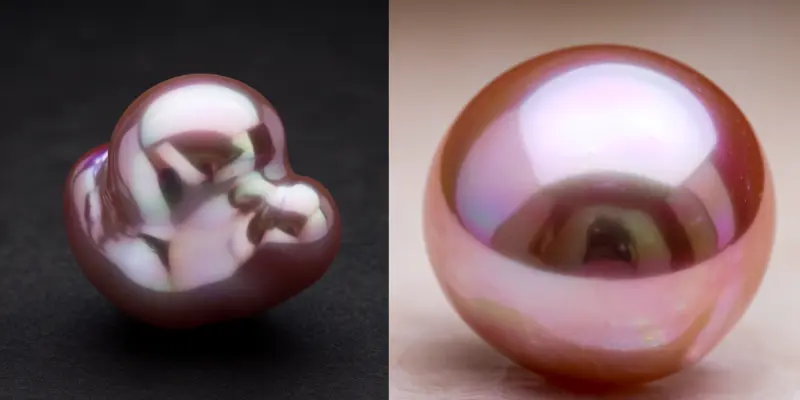
The intensity and uniformity of the pink color directly affect the pearl’s price. Pearls with rich, evenly distributed pink hues are considered more valuable. Some pearls may also show secondary hues, like lavender or peach, which can add extra appeal. Pearls from high-quality cultivars, such as Akoya or South Sea, often have better color intensity and evenness.
Matching

When pearls are strung together in jewelry, like necklaces or earrings, matching them in terms of size, shape, and color increases their value. Matching pearls are rarer, especially in large quantities, as they must come from the same harvest and have similar characteristics. The more uniform the pearls, the higher the price of the set.
Other Factors That Impact the Value of Pink Pearls
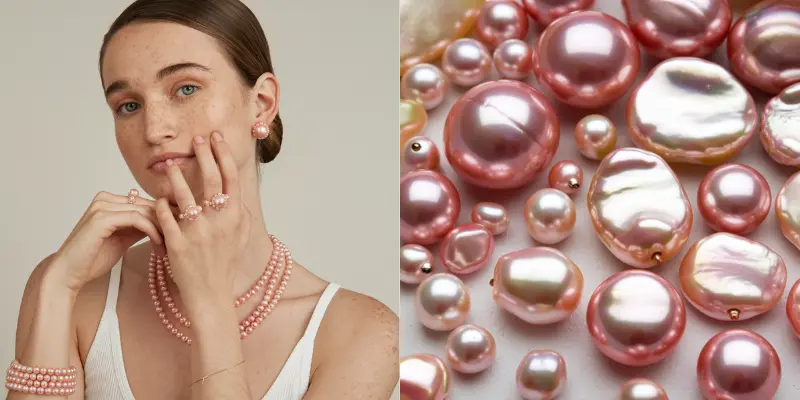
There are several other factors beyond shape, size, and surface quality that can impact the value of pink pearls. These factors include the origin, popularity, brand, and whether the pearl is natural or cultured. Let’s dive deeper into each of them.
Origin

The location where the pink pearl is grown plays a huge role in its value. Pearls from certain regions are more highly valued due to their rarity, quality, and the conditions in which they are grown.
- Akoya Pearls (Japan): Known for their high luster and round shape, Akoya pearls are often regarded as the finest. They tend to be more expensive because they’re farmed in a controlled environment, ensuring consistent quality.
- South Sea Pearls (Australia, Indonesia): These are larger and rarer, often coming in shades of pink or peach. Their size and unique colors increase their value.
- Tahitian Pearls (Tahiti, French Polynesia): Though typically black or dark-colored, Tahitian pearls with pink overtones can fetch higher prices due to their exotic origin and rarity.
Popularity of Pink Pearls
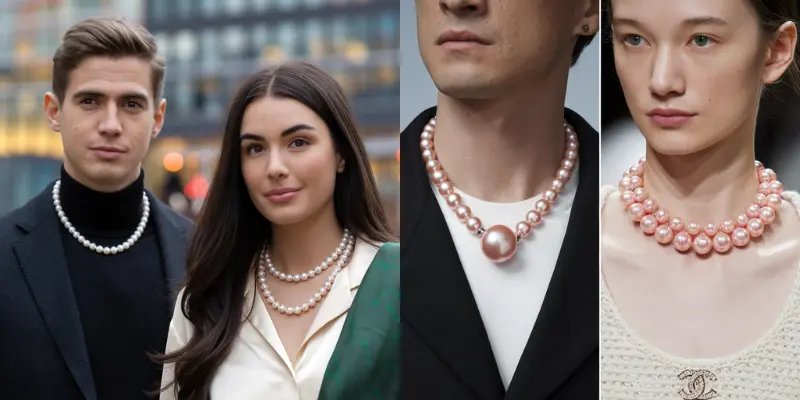
The current demand for pink pearls can influence their price. Pink pearls are becoming more popular in the fashion world, and this increased demand often raises the price.
- Fashion Trends: As more celebrities and influencers wear pink pearls, demand for these jewels rises, pushing prices higher.
- Cultural Significance: Pink is often associated with beauty, love, and femininity, which adds to the appeal of pink pearls.
Brands

The brand behind a pink pearl piece can significantly impact its price. High-end brands are known for their superior quality, craftsmanship, and design. Pearls sold by these brands often carry a premium price tag.
- Luxury Brands (Mikimoto, Tiffany, etc.): Pearls from top designers or luxury brands are priced higher because of their brand reputation, skilled craftsmanship, and unique designs.
- Independent Designers: Well-regarded independent jewelers can also increase the value of a pearl due to their custom, handcrafted pieces.
Pearl Price Comparison Guide
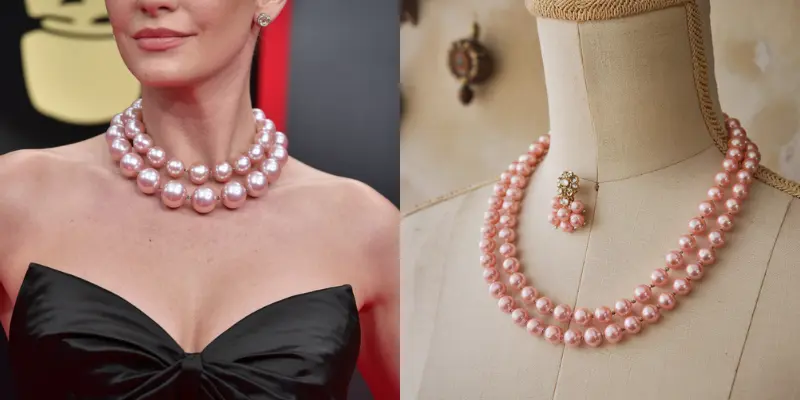
Understanding how different factors affect the price of pearls is essential when making a purchase. Here’s a breakdown of how pink pearls compare to other types, and how aspects like color, shape, size, luster, and surface quality influence the price, along with approximate price ranges.
Price Comparison on Different Types of Pearls
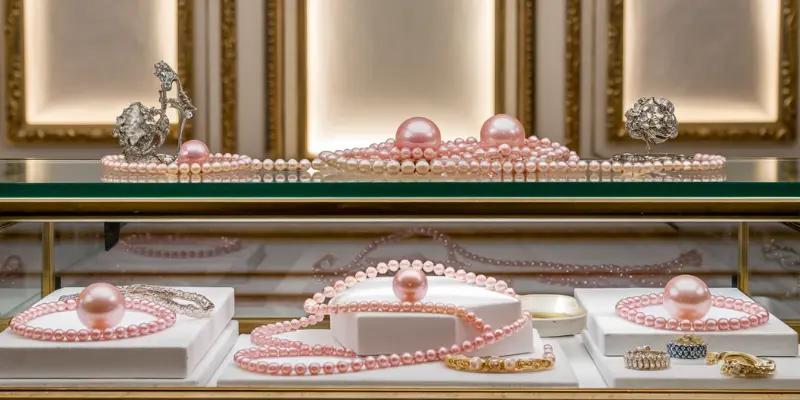
When comparing pink pearls to other types of pearls, here’s how their prices typically stack up:
- Pink Pearls vs. White Pearls:
- Price Range for Pink Pearls: $300 – $2,000 (depending on size, shape, and quality).
- Price Range for White Pearls (Akoya): $100 – $2,000 (though high-end ones can exceed $2,000).
White pearls, especially from Akoya farms, tend to be less expensive than pink pearls, but the higher-quality ones can reach similar prices.
- Pink Pearls vs. Black Pearls (Tahitian Pearls):
- Price Range for Tahitian Black Pearls: $500 – $3,000 (depending on size, shape, and color).
Black pearls are generally more expensive than pink pearls due to their rarity and exotic origin. However, high-quality pink pearls can still be close in price to good-quality Tahitian pearls.
- Price Range for Tahitian Black Pearls: $500 – $3,000 (depending on size, shape, and color).
- Pink Pearls vs. South Sea Pearls:
- Price Range for South Sea Pearls: $1,000 – $15,000 (depending on size, origin, and quality).
South Sea pearls are generally more expensive because of their large size and rarity. Pink pearls, however, can still be pricey if they’re larger or have a very unique color.
- Price Range for South Sea Pearls: $1,000 – $15,000 (depending on size, origin, and quality).
How Pearl Color Impacts the Value of Pearls
The color of a pearl is a major determinant in its price. Here’s how different shades of pink affect the cost:
- Light Pink Pearls:
- Price Range: $300 – $800
Lighter pink pearls are more common and tend to be the least expensive. However, pearls that have a perfectly smooth surface and good luster can push the price higher within this range.
- Price Range: $300 – $800
- Medium Pink Pearls:
- Price Range: $600 – $1,500
Medium pink pearls are more desirable and generally cost more than lighter shades. Their rich, balanced color makes them popular and in demand.
- Price Range: $600 – $1,500
- Dark Pink Pearls (Mauve, Rose, etc.):
- Price Range: $1,000 – $2,500
Darker shades of pink, like mauve or rose, are rarer and more expensive. Pearls with a deeper color often have a premium due to their unique, striking appearance.
- Price Range: $1,000 – $2,500
Most Valuable Pearl Shape
Pearl shape affects its pricing, with perfectly round pearls typically commanding the highest price:
- Round Pearls:
- Price Range: $1,000 – $5,000
Round pearls are the most valuable because of their symmetry. Perfectly round and smooth pearls are considered the pinnacle of quality, especially if they have great luster.
- Price Range: $1,000 – $5,000
- Baroque Pearls (Irregular Shape):
- Price Range: $300 – $1,500
Baroque or irregular-shaped pearls are typically more affordable due to their unique shapes and lower demand. However, they still hold value depending on their size and surface quality.
- Price Range: $300 – $1,500
How Pearl Size Impacts Its Value
The larger the pearl, the higher the price:
- Small Pearls (under 7mm):
- Price Range: $300 – $800
Smaller pearls are common and therefore less expensive. They may be used in designs like earrings or pendants where size isn’t the primary focus.
- Price Range: $300 – $800
- Medium Pearls (7mm – 9mm):
- Price Range: $800 – $1,500
These are the most popular sizes for everyday jewelry. Their price increases as the size goes up, especially if they have excellent luster and surface quality.
- Price Range: $800 – $1,500
- Large Pearls (over 9mm):
- Price Range: $1,500 – $5,000+
Larger pearls (over 9mm) are rare, and their price is much higher because they take longer to form. Larger, high-quality pink pearls are highly sought after.
- Price Range: $1,500 – $5,000+
How Pearl Luster and Nacre Quality Affect Value
Luster and nacre thickness are key to a pearl’s value:
- High Luster Pearls:
- Price Range: $1,000 – $4,000
Pearls with bright, reflective luster tend to be priced higher. The stronger the luster, the more valuable the pearl is because it makes the pearl appear more radiant.
- Price Range: $1,000 – $4,000
- Thick Nacre Pearls:
- Price Range: $1,500 – $3,000
Pearls with thick nacre are durable and shine better, making them more expensive. Thin nacre pearls are priced lower because they are more prone to damage and don’t shine as brightly.
- Price Range: $1,500 – $3,000
How Pearl Surface Affects Worth
The smoother the surface, the higher the price:
- Flawless or Nearly Flawless Surface:
- Price Range: $1,000 – $3,000
Pearls that are free from blemishes or scratches are considered top-tier. These pearls are valued more because they have an ideal, smooth appearance and reflect light beautifully.
- Price Range: $1,000 – $3,000
- Imperfections on the Surface:
- Price Range: $300 – $1,500
Pearls with visible blemishes or imperfections are less expensive because they don’t look as flawless. However, some buyers still prefer irregularities for their unique charm.
- Price Range: $300 – $1,500
FAQs
1. Is a pink pearl rare?
Pink pearls are relatively rare compared to other pearl colors like white or black. They are usually found in freshwater pearls or Akoya pearls. Due to their rarity and unique color, they tend to be more expensive than other types of pearls.
2. What color pearls are most expensive?
The most expensive pearls are typically South Sea pearls, which come in white, gold, and sometimes pink. Black pearls, especially Tahitian pearls, are also highly valued. The darker the color and the more intense the luster, the higher the price tends to be.
3. Are pink pearls real or fake?
Yes, pink pearls are real and can be either cultured or natural. Cultured pink pearls are grown in freshwater or Akoya oysters, while natural pink pearls are rare and occur naturally. You can find high-quality pink pearls at reputable jewelers who specialize in genuine pearls.
4. What pearls are worth money?
The most valuable pearls are those with high luster, thick nacre, and few imperfections. South Sea pearls, Tahitian pearls, and Akoya pearls are among the most valuable types, with larger sizes and rare colors like pink or black. Pearls with perfect round shapes and smooth surfaces also tend to be worth more.
5. How do I know if a pink pearl is good quality?
To assess the quality of a pink pearl, look for a smooth surface, high luster, and thick nacre. The more even and rich the color, the more valuable it is. Also, consider the size—larger, well-formed pink pearls are typically worth more than smaller or imperfect ones.
Conclusion
So, now you’ve got a clear idea of how much pink pearls are worth and what really affects their value. From the size, shape, and color intensity to things like surface quality and nacre thickness, every detail plays a big role in the final price. The better the quality, the more beautiful and valuable your pink pearl will be.
Whether you’re buying pink pearls for yourself or as a gift, just remember to check the quality, origin, and overall finish. High-quality pink pearls aren’t just pretty, they hold their value and last for years. Now that you know what to look for, you’re ready to shop smart and pick a pearl that’s truly worth it!

- Be Respectful
- Stay Relevant
- Stay Positive
- True Feedback
- Encourage Discussion
- Avoid Spamming
- No Fake News
- Don't Copy-Paste
- No Personal Attacks

- Be Respectful
- Stay Relevant
- Stay Positive
- True Feedback
- Encourage Discussion
- Avoid Spamming
- No Fake News
- Don't Copy-Paste
- No Personal Attacks






